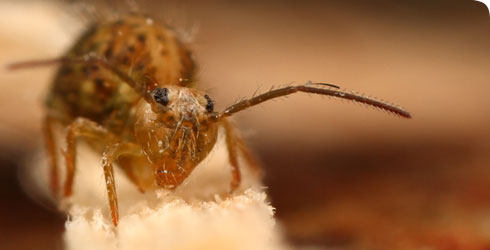Taxonomy
Like the insects, Sminthurus viridis has 6 legs. But as with all springtails it is wingless, has simple eyes and 2 characteristics that distinguish it from insects:
- the furca - a fused pair of appendages protruding from the fourth abdominal segment, which can ‘spring’ out from under the animal’s body and propel the animal very quickly, high into the air (hence the name flea)
- the ventral tube - a pair of appendages protruding from the first abdominal segment, which can be used in several ways:
- as suction pads to attach the animal to the soil substrate
- to ‘right’ itself if it lands upside down after springing with the furca
- to suck up fluids
Sminthurus viridis is relatively large by springtail standards, and adults can be up to 3mm in length.
It is a member of the Sminthuridae family - the globular springtails, which have bodies shaped like 2 spheres stuck together.
S. viridis has several distinguishing characteristics:
- the fourth antennal segment is divided into 18 subsegments
- there are long dorsal macrosetae (hairs) on the abdomen
- the dorsal edges of the mucro are smooth
- the body is green or yellow in colour, with variable brown mottled dorsal pigmentation
- males are smaller than females and have antennae adapted for grasping the females when mating
The springtails were thought to be in a sister class to the insects - the Entognatha. However, some recent DNA studies have elevated them to a separate class - the Collembola. Other studies have placed them in a group closer to the crustaceans - the Pancrustacea, which have similarities to both the Insecta and Crustacea. There is much debate as to the evolutionary origin of the springtails.
Toolbox
Glossary
Mucro
The tips at the end of the paired appendages making up the furca. The shape of the mucro and arrangement of hairs on it may be used in springtail species identification.
